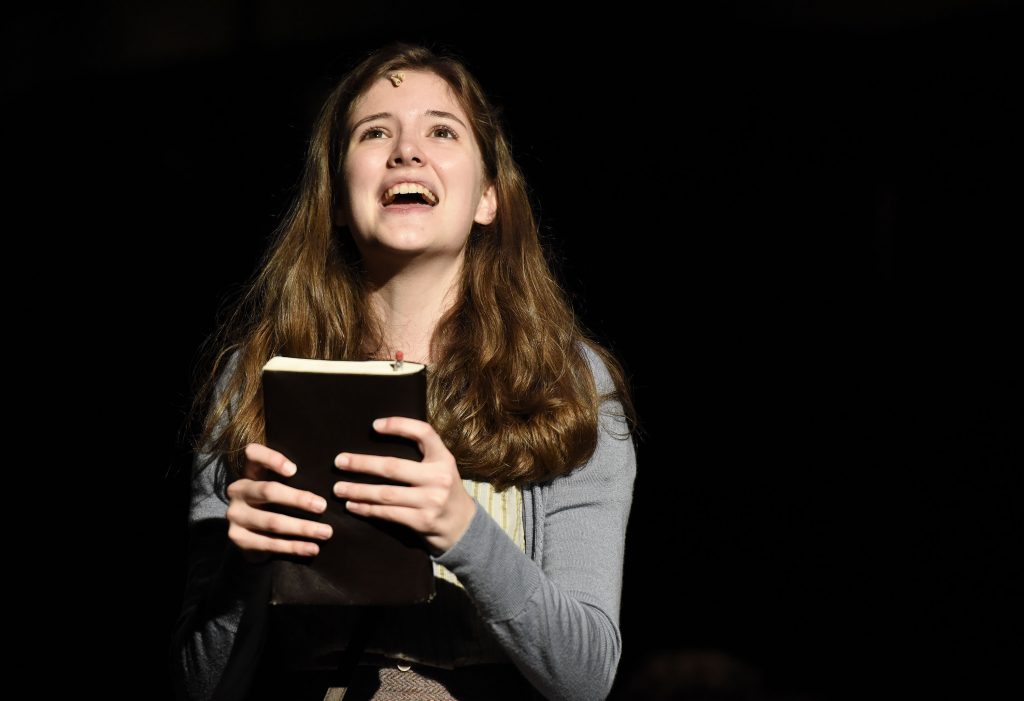
Before high school track star Colin Thompson was set to begin his college career at Carolina, he was in a car accident that left him with a severe traumatic brain injury. He had to relearn how to walk, talk and eat.
Thompson’s positive attitude and determination in the face of serious life obstacles made him the perfect guest speaker for a new interdisciplinary course in the College of Arts & Sciences called “Health and Happiness.”

On a February afternoon in Fetzer Hall, Thompson, who’s now a senior exercise and sport science major, shared this Aristotle quote with his peers: “Happiness is a state of activity.”
“Happiness is the path you are on,” said Thompson, who was invited to speak by professor Claudio Battaglini. “Don’t focus on the negatives, and don’t take anything for granted. Capitalize on the opportunities you have in front of you.”
Earlier that morning, across campus in Hanes Art Center, students had gathered in a similar “big ideas” class with a heavier topic — “Death and Dying.” Teaching professor Jeannie Loeb invited students to respond to a question via Poll Everywhere software, which encourages interactive class participation in real time. She asked: “What are your favorite ways of distracting yourself from a distressing situation when you get extremely upset?”
Netflix, exercise, music, dogs and cats surfaced on a big screen in front of the room as among the top stress-reliever activities suggested by students. Instructors discuss serious topics like suicide prevention, funeral customs and euthanasia, but try to end each class on a lighter note (like sharing a video of Rusty the narcoleptic dog.)
Ideas, information and inquiry

“Health and Happiness” and “Death and Dying” are two of five “Ideas, Information and Inquiry” courses, also called “Triple I” or “III” for short, that are being pilot-tested in spring 2019. The large classes are organized around a broad theme and are team-taught by outstanding faculty members in three disciplines. They are designed to introduce students to new ideas, new modes of inquiry and essential skills, and they emphasize key capacities of data literacy, global orientation, principles of evidence and collaboration.
Triple I courses are core offerings in the proposed new General Education curriculum — called IDEAs in Action. The courses would be required for first-year students and encouraged for transfer students.
Additional spring courses include “Philosophy, Politics and Economics,” “The Idea of Race” and “The Environment, Intersectionality and Science Fiction.”
Interdisciplinary benefits
Loeb (psychology and neuroscience) teaches “Death and Dying” with Tim Marr (American studies) and Jocelyn Chua (anthropology). Death and dying are shared experiences, yet there is great cultural variation in the ways people define, understand and treat death, dying and the relations between the living and the dead.
Human problems are inherently interdisciplinary, said Chua, and the Triple I courses highlight that.
“Being able to work with people from different disciplinary backgrounds to create solutions to complex human problems is important, especially in an increasingly global world,” Chua said. “The earlier we can expose students to these kinds of dialogues, and [illustrate] that research shouldn’t be a siloed experience, the better.”

“Thinking about death is a universal way to make meaning out of life,” added Marr. For students, many of whom may not have experienced the loss of someone close to them, “it may create a natural community of experience they can build on.”
Loeb had the idea for the course and searched the UNC web site for “death and dying” when looking for potential collaborators. Marr and Chua’s names popped up. “I don’t know if that’s a good or a bad thing,” Loeb said, joking. All kidding aside, she added that it’s been amazing to team up with her new colleagues on this. They meet with their graduate teaching assistants in the Campus Y or for lunch after each class to brainstorm and de-brief.
Battaglini (exercise and sport science) teaches “Health and Happiness” with Barbara Fredrickson (psychology and neuroscience) and Arne Kalleberg (sociology). Kalleberg and Fredrickson knew each other from first-year seminars they both teach that address aspects of happiness, and Battaglini and Fredrickson had submitted grant proposals together.
In the course, students are exposed to the ideas of happiness and well-being from the disciplines of physiology, positive psychology and sociology. They are also learning important life skills such as cultivating teamwork, developing social connections, being physically active and more.
The three “Happiness” professors said students are not the only ones who benefit from the interdisciplinary nature of Triple I courses. They said teaching the class together has given them new insights about teaching styles and ways to team up for future research.

“In my area, I need more of their expertise, because the million-dollar question for us in exercise and sport science is, how can you get people to engage and sustain levels of physical activity for a prolonged period of time?” Battaglini said. “You start thinking of psychological and sociological forces behind that.”
Fredrickson echoed the need for experts outside her field as it relates to her own work on positive emotions, particularly as she explores new research directions.
“The most interesting and pressing questions that face us in social and hard sciences require interdisciplinary approaches,” she said. “We need to get students thinking across these lines more fluidly.”
Kalleberg said team-teaching the class has been “pure joy and a natural fit.”
For undergraduates who are not sure what to major in, “Triple I” courses may spark their interest in different majors and careers, he added.
Engaging students
Faculty members are using a variety of techniques to encourage class participation and to make these big classes feel small.

In “Health and Happiness,” students are divided into “flocks” (group of Rams) and required to do happiness-promoting activities together outside of class throughout the semester. The faculty trio also hosts non-alcoholic “happy hours” where students can chat with them informally after class, and they offer tours of exercise and sport science laboratories. Students are gaining data literacy skills by working with their flockmates to test different hypotheses by analyzing class data related to the course theme. They will prepare scientific posters showcasing their results.
The “Death and Dying” team encourages students to answer various questions on index cards, then they gather in small groups to trade cards with a class member they don’t know to discuss their answers. Students are also working together to create a collective WordPress site. In a small group “pod,” they are posting about a specific issue related to cultural, scientific and ethical issues of death and dying.
Raymond Chen, a student in “Death and Dying,” said he appreciates the variety of topics addressed in the syllabus.
“One day we’ll talk about the history behind stand-your-ground laws; another day we’ll read an article on cryonics. We also learned how suicide takes on many cultural forms,” he said.
After a tough fall semester, Chika Adiele said she enrolled in “Health and Happiness” with the goal of adding to her “happiness toolbox.”
“My favorite part of the course so far was the day Dr. Battaglini talked about the physiological benefits of exercise in terms of our happiness and health,” she said. “It was mind-blowing.”
By Kim Spurr




